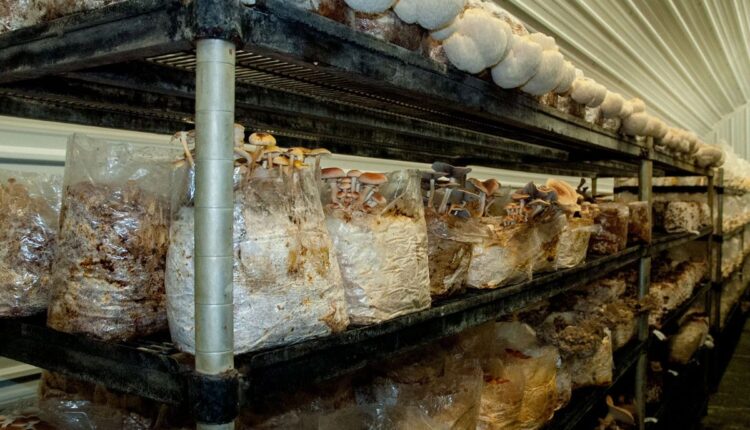Farming with Fungi: How Mycorrhizal Science Can Reduce Fertilizer Dependence
Harnessing the hidden allies in soil to grow healthier, cost-effective crops for Indian farmers
Farming with Fungi: India’s farmers face a constant struggle: growing more from less — less water, less fertile soil, and rising costs of fertilizers. But beneath their very feet lies an ancient ally that can help: fungi.
Specifically, a special type of fungi known as Arbuscular Mycorrhizal Fungi (AMF). These microscopic fungi form symbiotic relationships with plant roots, acting like natural extensions of the root system. They are revolutionizing how Indian farmers can think about soil health and cut down on expensive chemical fertilizers, especially phosphorus-based ones.
What Are Mycorrhizal Fungi?
The word “mycorrhiza” comes from Greek: “mykes” (fungus) and “rhiza” (root). These fungi attach themselves to crop roots and grow long thread-like structures called hyphae, which:
• Explore more soil area than roots alone can
Absorb nutrients, especially phosphorus, and pass them to the plant
• In return, the plant gives the fungi some sugars it produces through photosynthesis
This mutually beneficial system has existed in nature for millions of years, and Indian researchers are now working to bring it back into mainstream agriculture.
Why Indian Soil Needs Mycorrhiza ?
Indian soils, especially in Punjab, Uttar Pradesh, Maharashtra, and Tamil Nadu, are showing signs of:
• Phosphorus fixation (phosphorus is present but unavailable to plants)
Declining organic matter
• Heavy dependence on DAP and superphosphate fertilizers
But adding more chemical phosphorus isn’t the best solution — it’s expensive, inefficient, and damaging to soil health in the long run.
Here’s where AMF come in:
They help unlock “bound” phosphorus in the soil, improving uptake by 30–60%, especially in:
• Wheat and maize (common Rabi crops)
Pulses like moong, urad, and tur
• Cotton and sugarcane in dryland regions
Indian Research Leading the Way
Several Indian institutions have made breakthroughs in using AMF for mainstream farming:
1. ICAR–National Bureau of Agriculturally Important Microorganisms (NBAIM), Mau
NBAIM has developed and tested AMF inoculants specifically suited for Indian soils and climate. Trials in Uttar Pradesh and Bihar showed 20–30% yield increase in wheat with 50% less phosphorus fertilizer when AMF was applied.
2. Indian Institute of Pulses Research (IIPR), Kanpur
In black gram and pigeon pea trials, IIPR found that AMF improved root biomass, drought resistance, and phosphorus uptake even in low-input farms. Pulse-growing farmers in Bundelkhand saw better yields despite poor soils.
3. Tamil Nadu Agricultural University (TNAU)
TNAU’s long-term field trials in cotton and sugarcane fields showed that AMF combined with farmyard manure (FYM) improved both yield and fibre quality — while cutting DAP use by 40%.
4. University of Agricultural Sciences (UAS), Dharwad
UAS has worked on AMF application in ragi, groundnut, and cotton, showing that bio-inoculation with native fungi reduces phosphorus runoff, thus protecting nearby water bodies.
Farmer Benefits: Less Cost, More Growth
| Challenge | How AMF Helps |
| High fertilizer prices | Reduces need for phosphorus-based fertilizers like DAP |
| Poor soil fertility | Improves nutrient availability and root growth |
| Water scarcity | Enhances water absorption and drought tolerance |
| Soil degradation | Supports organic matter buildup and microbial health |
Example:
In Maharashtra, a farmer growing tur and soybean in red soil fields reduced his DAP use by half by using an AMF-coated seed treatment. He saved ₹1,200 per acre and saw healthier crops with deeper roots.
How Can Indian Farmers Use AMF?
1. AMF Inoculants (जैव कवक खाद):
• Available in powder, granular, or liquid form
Can be applied to seed, root, or soil
• Should be stored in cool conditions and used before expiry
2. Combine With Organic Inputs:
Using AMF along with FYM, compost, or vermicompost gives the best results — as organic matter helps fungi multiply faster.
3. Apply During Sowing:
Inoculating seeds or roots at sowing time allows early root-fungi bonding, boosting nutrient absorption from day one.
4. Avoid Excess Chemicals:
Avoid overuse of chemical fungicides or phosphorus fertilizers near the time of inoculation, as they can kill the fungi or reduce effectiveness.
Farmer Training and Demonstrations: Taking Mycorrhiza from Lab to Land
Even the best agricultural technology needs proper demonstration and trust-building before it reaches the hands of farmers — especially when it comes to invisible helpers like fungi!
To make AMF (Arbuscular Mycorrhizal Fungi) more accessible and acceptable, several Krishi Vigyan Kendras (KVKs) and ICAR-affiliated institutions across India have taken the lead in farmer outreach and practical training.
Where It’s Happening and What Farmers Are Learning
1. Jharkhand – Tribal Farmers in Focus
KVKs in Gumla, Khunti, and Ranchi have conducted trials on pulses and maize, where AMF is introduced through seed treatment and nursery application.
• Result: Farmers reported healthier root systems and more pods per plant in urad and tur.
• Tribal Self-Help Groups (SHGs) are now making home-based AMF mixtures using compost and local soil fungi.
2. Chhattisgarh – Dryland Cotton and Millets
KVKs under Indira Gandhi Krishi Vishwavidyalaya (IGKV) have demonstrated the use of AMF in cotton and kodo millet, especially in Bastar and Dantewada.
• Result: With 50% less chemical phosphorus, yields improved by 15–20%, and soil quality was preserved.
• Farmers were also trained in preparing bio-input pits, using FYM and fungal culture.
3. Odisha – Rice-Fallow Intensification
KVKs in Mayurbhanj and Kalahandi worked with tribal farmers practicing rice-fallow cultivation, where pulses are sown after paddy without irrigation.
• AMF helped pulses survive better in low-moisture soil, improving nutrient uptake and drought tolerance.
• Women farmers were trained in low-cost inoculation techniques for seed treatment using clay and cow dung.
What Do These Demonstrations Teach?
Each demo plot and training program is designed to answer:
• What is AMF and how does it work with roots?
How to apply AMF at sowing or transplanting time?
What changes to expect in root growth and crop appearance?
How to reduce phosphorus fertilizer and still get better yield?
• How to combine AMF with compost or vermicompost for best results?
The visual difference in root mass and plant vigor is shown right on the demo plot — helping farmers believe what they see.
Farmer-to-Farmer Learning Model
Many KVKs are also using the “Lead Farmer” approach, where one progressive farmer is trained and supported to adopt AMF on his plot. Once others see the results:
• They are more willing to try biofertilizers
• Input sellers start stocking AMF products
Local cooperatives and FPOs begin bulk purchasing for wider distribution
This bottom-up spread of trust and adoption is working well in tribal, hilly, and semi-arid regions.
Government Support and Convergence
These demonstration projects are often funded under:
National Mission on Sustainable Agriculture (NMSA)
Rashtriya Krishi Vikas Yojana (RKVY)
• Tribal Sub-Plan (TSP) allocations under ICAR
• State Natural Farming Missions (e.g., in Andhra Pradesh and Himachal Pradesh)
The convergence of science, state schemes, and ground-level training is turning AMF from an obscure research term into a practical solution in Indian fields.
Challenges to Widespread Adoption
| Problem | Solution |
| Lack of awareness | Use farmer fairs, WhatsApp groups, local KVKs to spread knowledge |
| Availability issues | Promote local production of AMF inoculants via agri-startups and FPOs |
| Doubts about results | Showcase model plots and farmer-to-farmer learning |
Environmental Bonus: Clean Fields, Clean Rivers
One of the lesser-known but serious side effects of modern farming is water pollution caused by chemical fertilizers — especially phosphorus-based fertilizers like DAP (Di-Ammonium Phosphate) and SSP (Single Super Phosphate).
What Happens?
When farmers apply excess phosphorus fertilizers:
Plants can’t absorb all of it at once.
The leftover phosphorus runs off with rain or irrigation water.
It enters nearby ponds, lakes, and rivers, including major Indian rivers like the Ganga, Krishna, Yamuna, and Godavari.
This runoff leads to a dangerous problem called eutrophication — a condition where water bodies become overly rich in nutrients, causing: Algal blooms (green layers on water)
Oxygen depletion, killing fish and aquatic life
• Contaminated water for both irrigation and drinking
• Disruption of the local ecosystem and biodiversity
How AMF (Arbuscular Mycorrhizal Fungi) Helps Prevent This
By improving the plant’s ability to absorb phosphorus more efficiently, AMF ensures that less fertilizer is needed, and less is left behind in the soil to be washed away.
Benefits for farmers and nature:
• You get better crop yield using half the usual fertilizer
The soil retains more organic matter and microbial life
Nearby rivers and ponds stay cleaner and healthier
• Fish, frogs, and beneficial insects in the region thrive again
National Mission Support: PM-PRANAM Scheme
India has launched the PM-PRANAM (Promotion of Alternate Nutrients for Agriculture Management) scheme to reduce chemical fertilizer usage and promote natural farming practices. AMF-based farming aligns perfectly with this goal.
Under this scheme:
States are rewarded for reducing chemical fertilizer consumption
• Farmers using biofertilizers, compost, and fungi-based products can get subsidy support and training
• Awareness campaigns promote the environmental and economic value of microbial inputs like AMF
Let Fungi Do the Work
Farmers in India are often forced to choose between high input costs and low productivity. But with mycorrhizal fungi, they have a silent partner underground — working 24/7 to feed their crops naturally.
With proper support, training, and access to quality AMF products, even small and marginal farmers can grow more with less, protect the environment, and reduce their dependence on chemical fertilizers.
As one progressive farmer in Madhya Pradesh put it:
“Khaad kam, phir bhi fasal zyada — yeh jaadu to fungi ka hai!”
Contact details: If farmers want to share information or experiences related to farming with us, then they can do this by calling us on the phone number 9599273766 or by writing an email to [email protected] or by sending your recording. Through Kisan of India, we will convey your message to the people, because we believe that if the farmers are advanced then the country is happy.



